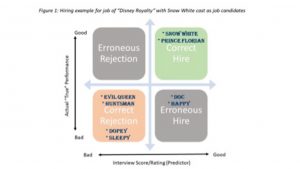Refine interviewing process for better results
Jill Bradley-Geist, College of Business, Colorado Springs Business Journal
The primary purpose of employee selection interviews is improving your odds both of hiring candidates who will be good employees and of rejecting those who would not be good employees.
Problem: My organization has been in continuous hiring mode, and our batting average is atrocious. Time and again we hire people who ace the interviews but ultimately prove to be a bad fit. How can we make better hiring decisions?
A good way to begin to improve your hiring process is to understand how to conduct more discerning interviews. And yes, if you've glanced ahead to Figure 1 and noticed names like Dopey and Doc, we will - in all seriousness - analyze this approach with the example of Snow White and her fellow cast members serving the role of hypothetical job candidates. Figure 1 depicts job candidates in a classification system based on their predicted performance deduced from the interview versus their actual/true performance.
Importantly, how you define performance will vary depending on the job. That is, you need to know whether you are (using the Snow White scenario) hiring for the job of Disney royalty versus, say, a Queen's huntsman or a gem miner. Take for example, Grumpy, Bashful and Sneezy, all of whom could be suitable or unsuitable depending on the job in question. However, it would be unfair to eliminate these candidates from consideration for jobs in which one's grumpiness, bashfulness and/or frequent sneezing bear no relation to performance (e.g., grumpiness may prove desirable for Evil Queen's huntsman whose job includes offing Snow White).
 The primary purpose of employee selection interviews is improving your odds both of hiring candidates who will be good employees and of rejecting those who would not be good employees. In this regard, Figure 1 shows both "correct" hiring decisions and two types of hiring "errors" - erroneous hires (hired candidates you should have rejected) and erroneous rejections (rejected candidates you should have hired). Snow White herself is a "correct hire," meaning she scored favorably for both predicted performance and actual performance. Evil Queen is a "correct rejection" meaning both her predicted and actual performance (if she were hired) are similarly gloomy. Of note, the stringency (or leniency) of hiring standards (i.e., the "cutoff score") will impact your rate of "hits" and "misses."
The primary purpose of employee selection interviews is improving your odds both of hiring candidates who will be good employees and of rejecting those who would not be good employees. In this regard, Figure 1 shows both "correct" hiring decisions and two types of hiring "errors" - erroneous hires (hired candidates you should have rejected) and erroneous rejections (rejected candidates you should have hired). Snow White herself is a "correct hire," meaning she scored favorably for both predicted performance and actual performance. Evil Queen is a "correct rejection" meaning both her predicted and actual performance (if she were hired) are similarly gloomy. Of note, the stringency (or leniency) of hiring standards (i.e., the "cutoff score") will impact your rate of "hits" and "misses."
So how do you identify the good from the bad before you hire (or reject) them? After all, Evil Queens sometimes pose as innocent apple peddlers. Fortunately, there is a vast amount of rigorous research demonstrating the advantages of structured versus unstructured interviews. Although structured interviews require more up-front investment to develop, their expected payoff is increased validity and utility (i.e., better hiring decisions and return on investment). Unfortunately, despite being an incredibly poor predictor of performance, the unstructured interview remains the most commonly used selection tool amongst employers. The action items below are meant to help you develop more structured (and thereby more useful) interviews.
Action items
1. Aim for consistency in candidate interview experience. To make a fair comparison across candidates, they should all be asked the same basic set of questions and evaluated using the same basic criteria.
2. When writing interview questions:
- The content of your questions should start with the particulars of the job. What are the requirements? What knowledge, skills and abilities are required to be successful?
- Second, think behavior, behavior, behavior. The Achilles' heel of the interview is its potential for faking. Interviewees are prone to reveal maximum performance versus typical performance because they are on their best behavior. Behavioral interview questions reduce faking compared to many standard fare questions. Compare, for example, the following questions:
- If hired, what strengths would you bring to this job?
- Please describe a situation in which you failed to meet an important goal at work.
People come into an interview expecting questions like the first and have generic "fluff" answers prepared (e.g., team player; ethical; hard worker). The second question is much harder for interviewees in terms of deducing/concocting the "correct" answer.
3. Include an "RJP" (realistic job preview). Yes, you want to impress good candidates, however experts recommend against overselling the job. Providing candidates with a realistic picture, both good and bad, encourages poor-fitting applicants to self-select out, thereby reducing erroneous hires.
Jill Bradley-Geist is an associate professor in the College of Business at UCCS teaching courses in management and human resources. Her research has been published in top-tier journals and has been covered in media outlets including the Washington Post, The New York Times, and USA Today. Contact: OPED@uccs.edu.